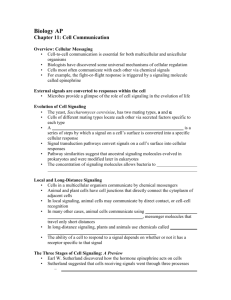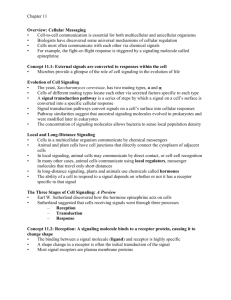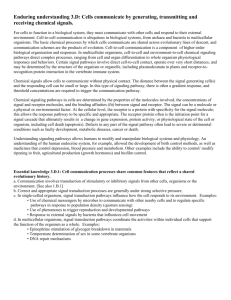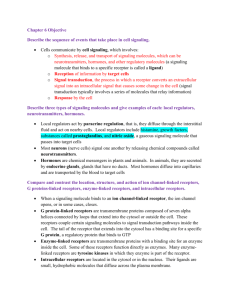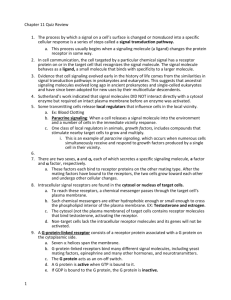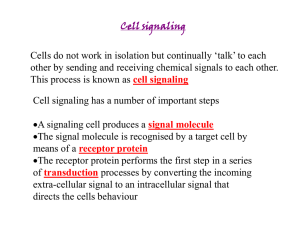Signal Transduction Pathways
advertisement
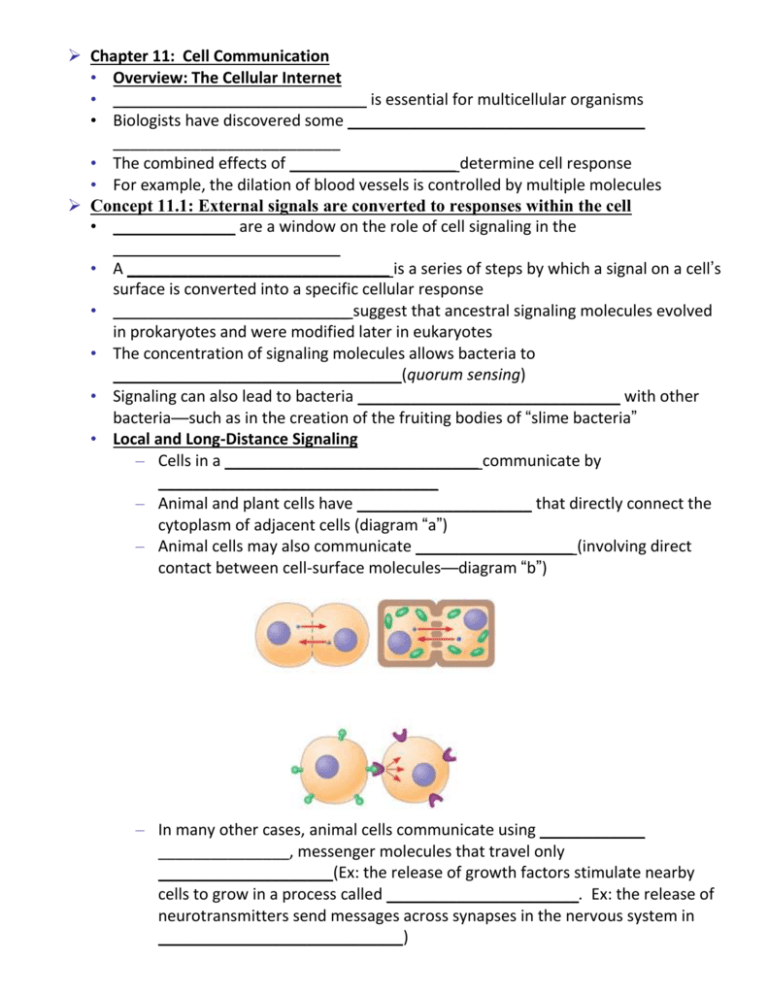
Chapter 11: Cell Communication • Overview: The Cellular Internet • _____________________________ is essential for multicellular organisms • Biologists have discovered some __________________________________ __________________________ • The combined effects of ___________________ determine cell response • For example, the dilation of blood vessels is controlled by multiple molecules Concept 11.1: External signals are converted to responses within the cell • ______________ are a window on the role of cell signaling in the __________________________ • A ______________________________ is a series of steps by which a signal on a cell’s surface is converted into a specific cellular response • ___________________________ suggest that ancestral signaling molecules evolved in prokaryotes and were modified later in eukaryotes • The concentration of signaling molecules allows bacteria to _________________________________(quorum sensing) • Signaling can also lead to bacteria ______________________________ with other bacteria—such as in the creation of the fruiting bodies of “slime bacteria” • Local and Long-Distance Signaling – Cells in a _____________________________ communicate by ________________________________ – Animal and plant cells have ____________________ that directly connect the cytoplasm of adjacent cells (diagram “a”) – Animal cells may also communicate __________________ (involving direct contact between cell-surface molecules—diagram “b”) – In many other cases, animal cells communicate using ____________ _______________, messenger molecules that travel only ____________________(Ex: the release of growth factors stimulate nearby cells to grow in a process called ______________________. Ex: the release of neurotransmitters send messages across synapses in the nervous system in ____________________________) – In ___________________________, plants and animals use chemicals called ____________________ • The Three Stages of Cell Signaling: A Preview – Earl W. Sutherland discovered how the hormone ________________ acts on cells – Sutherland suggested that cells receiving signals went through three processes: • ________________—a chemical signal is “detected” when a signaling molecule binds to a receptor protein • _________________—each relay molecule brings about a change in the next molecule • _________________—the specific cellular response is triggered by the last relay molecule. Concept 11.2: Reception: A signal molecule binds to a receptor protein, causing it to change shape • ____________ —any molecule that specifically binds to another molecule • The binding between a signal molecule (___________) and receptor is ______________________ • Ligand binding usually causes a shape change in a receptor which is the initial transduction of the signal • Most signal receptors are ________________________________ • Receptors in the Plasma Membrane – Most water-soluble signal molecules bind to specific sites on receptor proteins in the ____________________________ – There are __________________________________________: • _________________________________ • _________________________________ • _________________________________ – A ________________________ is a plasma membrane receptor that works with the help of a ________ (a protein that binds GDP or GTP) • The G protein acts as an on/off switch: If GDP is bound to the G protein, the G protein is inactive. If GTP binds, the G protein becomes active (see diagram) – ______________________________ are membrane receptors that attach _______________________________ • A ____________ is an enzyme that catalyzes the transfer of phosphate groups • A receptor tyrosine kinase ____________________________ ____________________________________ – A _________________________ receptor acts as a gate when the receptor changes shape • When a signal molecule binds as a ligand to the receptor, the gate + 2+ _________________, such as Na or Ca , ____________________ ______________________ • Intracellular Receptors – Some receptor proteins are ________________, found in the _____________ or ______________ of target cells – ____________________________________________ can readily cross the membrane and activate receptors – Examples of hydrophobic messengers are the ___________________ hormones of animals – An activated hormone-receptor complex can act as a _______________________________, turning on specific genes Concept 11.3: Transduction: Cascades of molecular interactions relay signals from receptors to target molecules in the cell • ____________________ usually involves ______________________ • Multistep pathways can amplify a signal: A few molecules can produce a _______________________________ • Multistep pathways provide ________________________ for coordination and regulation of the cellular response • Signal Transduction Pathways – The molecules that relay a signal from receptor to response are mostly _________________ – Like falling dominoes, the receptor activates another protein, which activates another, and so on, until the protein producing the response is activated – At each step, the signal is transduced into a different form, ________________________________________________________ • Protein Phosphorylation and Dephosphorylation – In many pathways, the signal is transmitted by a ________________ ___________________________ – ______________________ transfer phosphates from ATP to protein, a process called _______________________ (see diagram) – _____________________________ remove the phosphates from proteins, a process called __________________________ which turns off the pathway if the initial signal is no longer present. – This phosphorylation and dephosphorylation system acts as a _____________________________, turning activities on and off • Small Molecules and Ions as Second Messengers – The extracellular signal molecule that binds to the receptor is a pathway’s “______________________” – ________________________ are small, nonprotein, water-soluble molecules or ions that spread throughout a cell by diffusion – Second messengers participate in pathways initiated by G protein-coupled receptors and receptor tyrosine kinases – _____________________________ are common second messengers • ________________________ is one of the most widely used second messengers, • ________________________, an enzyme in the plasma membrane, converts ATP to cAMP in response to an extracellular signal • Cyclic AMP is inactivated ______________________, an enzyme that converts it to AMP. – Many _____________________ trigger formation of cAMP – Other components of cAMP pathways are _____________________ _________________________________ – cAMP usually activates ________________________, which phosphorylates various other proteins – Further regulation of cell metabolism is provided by G-protein systems that _________________________________ – Understanding the role of cAMP in G protein signaling pathways has allowed us to better understand how _________________________. • Ex: Cholera, a disease that results in extremely severe diarrhea • Cholera bacteria produce toxins that modify the G protein that regulates salt and water secretion in the intestine. The modified G protein cannot hydrolyze GTP to GDP and thus remains stuck in the active form. This continuously stimulates adenylyl cyclase to make cAMP which causes the intestinal cells to secrete large amount of salts. Water moves by osmosis into the intestines causing profuse diarrhea. • Calcium Ions and Inositol Triphosphate (IP ) 3 2+ – __________________ (Ca ) act as a second messenger in many pathways – Calcium is an important second messenger because ______________________________ – Increasing the cytosolic concentration of calcium ions (which is normally low) causes many responses in animal cells, including muscle cell contraction, secretion of certain substances, and cell division. – A signal relayed by a signal transduction pathway _______________ _______________________________________ – Pathways leading to the release of calcium involve _____________ ____________________________as additional second messengers Concept 11.4: Response: Cell signaling leads to regulation of transcription or cytoplasmic activities • The cell’s response to an extracellular signal is sometimes called the “_______ _____________________” • Ultimately, a signal transduction pathway leads to regulation of one or more cellular activities • The response may occur ________________________ or ____________ _______________________________ • Many signaling pathways regulate the ______________ of enzymes or other proteins, usually by turning genes on or off in the nucleus • The final activated molecule may function as a _____________________ • Signaling pathways can also affect the physical characteristics of a cell, for example, ____________________. The mating of yeast cells is an example of this. • Fine-Tuning of the Response – Multistep pathways have two important benefits: • __________________________ (and thus the response) • _______________________________________________ • Signal Amplification – Enzyme cascades amplify the cell’s response – At each step, the number of activated products is _______________ than in the preceding step • The Specificity of Cell Signaling and Coordination of the Response – Different kinds of cells have different ____________________________ – These different proteins allow cells to __________ and ___________ to different signals – Even the same signal can have different effects in cells with different proteins and pathways – Pathway branching and “____________” further help the cell coordinate incoming signals • Signaling Efficiency: Scaffolding Proteins and Signaling Complexes – _____________________ are large relay proteins to which other relay proteins are attached – Scaffolding proteins can increase the signal transduction efficiency by ____________________________________________________ _____________________________________ • Termination of the Signal – ________________________ are an essential aspect of cell signaling – When signal molecules leave the receptor, the receptor __________ to its inactive state Concept 11.5: Apoptosis (programmed cell death) integrates multiple cell-signaling pathways • __________________ is programmed or controlled cell suicide • A cell is chopped and packaged into vesicles that are _________________ ____________________________ • Apoptosis prevents enzymes from leaking out of a dying cell and damaging neighboring cells • Apoptosis in the Soil Worm Caenorhabditis elegans – Apoptosis is important in shaping an organism during ____________ ___________________________ – The role of apoptosis in embryonic development was first studied in the soil worm, _____________________________ – In C. elegans, apoptosis results when specific proteins that “accelerate” apoptosis override those that “put the brakes” on apoptosis • Apoptotic Pathways and the Signals That Trigger Them – ___________________ are the main proteases (enzymes that cut up proteins) that carry out apoptosis – Apoptosis can be triggered by: • ________________________________________________ • ________________________________________________ • _________________________________________________ – Apoptosis ___________________________________ and is essential for the development and maintenance of all animals – Apoptosis may be involved in some diseases (for example, ___________________________________); interference with apoptosis may contribute to some __________________ You should now be able to: 1. Describe the nature of a ligand-receptor interaction and state how such interactions initiate a signaltransduction system 2. Compare and contrast G protein-coupled receptors, tyrosine kinase receptors, and ligand-gated ion channels 3. List two advantages of a multistep pathway in the transduction stage of cell signaling 4. Explain how an original signal molecule can produce a cellular response when it may not even enter the target cell 5. Define the term second messenger; briefly describe the role of these molecules in signaling pathways 6. Explain why different types of cells may respond differently to the same signal molecule 7. Describe the role of apoptosis in normal development and degenerative disease in vertebrates

